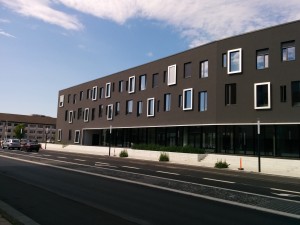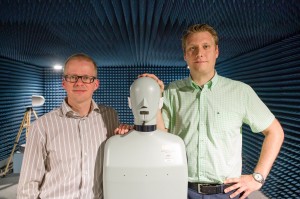 On May 23, the second workshop on the project Spatio-Temporal Filtering Methods for Enhancement and Separation of Speech Signals was held. Assoc. Prof. Richard Heusdens, Delft Tecnical University, gave an invited talk on distributed signal processing. Other that that, the program consisted of the following presentations:
On May 23, the second workshop on the project Spatio-Temporal Filtering Methods for Enhancement and Separation of Speech Signals was held. Assoc. Prof. Richard Heusdens, Delft Tecnical University, gave an invited talk on distributed signal processing. Other that that, the program consisted of the following presentations:
- J. R. Jensen, Near-field Localization of Audio: A Maximum
Likelihood Approach
- M. Abou-Zleikha A Tree-based Ensemble Learning for Speech
Processing
- S. M. Nørholm, Spatio-Temporal Audio Enhancement based on IAA
Noise Covariance Matrix Estimates
- B. Sturm, A Closer Look at Deep Learning Neural Networks with Lowlevel Spectral Periodicity Features
- V. Tavakoli, A Theoretical Study of the Speech Enhancement Problem
with Distributed Microphone Arrays
- S. Karimian-Azari, Robust Pitch Estimation Using an Optimal Filter on
Frequency Estimates
- J. R. Jensen, SMARD – A Single and Multi-Channel Audio Recordings Database
- J. K. Nielsen, Joint Sparsity and Frequency Estimation for Spectral Compressive Sensing
- J. K. Nielsen, Bayesian vs. Classical Statistics Through Three Examples
- H. Purwins, Audio Time Series Analysis: Experiments, Computational
Analysis, & Cognitive Models
- S. Karimian-Azari, Robust DOA Estimation of Harmonic Signals Using
Constrained Filters on Phase Estimates
- A. Jakobsson, High resolution sparse estimation of exponentially
decaying signals
- T. Kronvall, Joint DOA and Pitch Estimation using Block Sparse Techniques
- M. W. Hansen, Pitch-Based Acoustic Source Localization with
Distributed Microphone Arrays
- M. G. Christensen, Multi-Channel Maximum Likelihood Pitch Estimation
The participants this year were employees working on the Villum foundation projet as well as invited guests and colleagues at AAU: Richard Heusdens, Ted Kronvall, Andreas Jakobsson, Jesper Rindom Jensen, Jesper Kjær Nielsen, Mads Græsbøll Christensen, Vincent Tavakoli, Sam Karimian-Azari, Sidsel Marie Nørholm, Martin Weiss Hansen, Hendrik Purwins, Bob Sturm, Mohamed Abou-Zleikha.
 Audio Analysis Lab had two papers presented at the Asilomar Conference on Signals, Systems, November 2-5th, 2014. These were
Audio Analysis Lab had two papers presented at the Asilomar Conference on Signals, Systems, November 2-5th, 2014. These were


